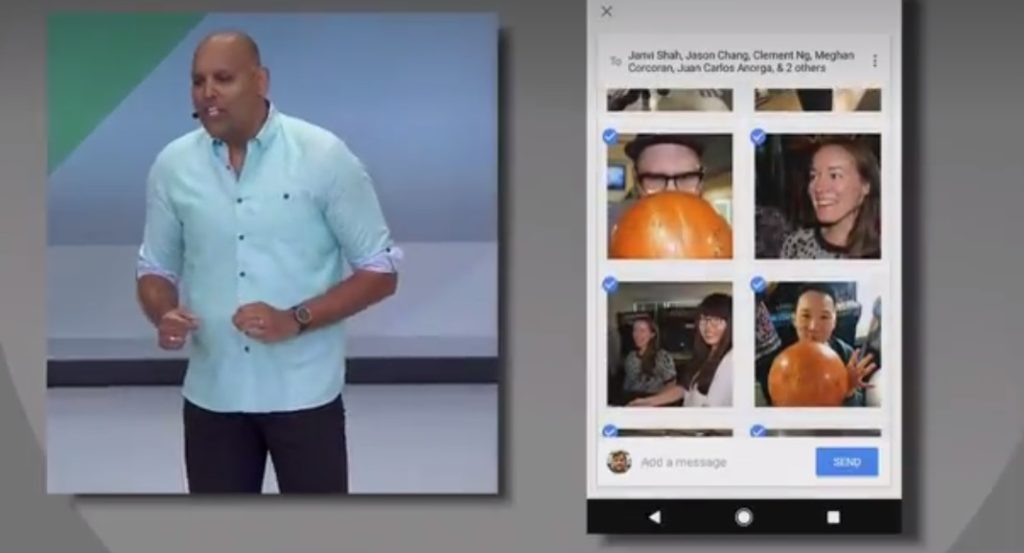Early today, several key Google members took the stage to kick off Google’s Annual developer focused I/O Keynote. As part of the 2-hour or so event, several new developments were announced across a slew of its products. Clearly Google seems to be focusing on its three A’s – Assistant, Android and AI.
The keynote began with CEO Sundar Pichai sharing some numbers. It has 2 billion active Android devices with 400 million being added since September 2015.
The Google Assistant
Google also announced that the Assistant would support transactions going forward and demoed the Assistant being used to complete a payment. Finally, Google announced support for multiple languages including French, German, Brazilian, Portuguese and Japanese by this Summer.

Google Home got some New Features
Google Home
- Proactive Assistance: Google Home will now be able to automatically notify you of important events without you having to ask it first. Thus for example, the device could see a rise in traffic levels and may inform you that you need to leave some time earlier to make it to your flight on time.
- Hands-Free Calling: Google Home is adding support for voice-enabled hands-free calling. You simply ask the assistant to call someone and it calls the concerned person. Also, its voice-recognition means that a simple command like Call Mom will call the concerned person’s mother depending on who said the command. As of now, calling is free on any landline and mobile in the United States with the option to display your phone number by linking it with Google Home.
- More Entertainment Options: Google is bringing Spotify’s free music service to the Google Home along with support for Soundcloud and Deezer. It has additionally also partnered with HBO Go and will add bluetooth support for the Home via a software update.
- Visual Responses: Now Google Home will be able to display additional information on the device of your choice. Thus for example, asking Google Home for directions could mean Google Home will display the directions on your phone’s screen. Or asking it to play a video could result in it playing it on your TV.

Google VP of Photos, Anil Sabharwal, demos Suggested Sharing in Google Photos
Google Photos
- Suggested Sharing: Google Photos now automatically suggests the best pics to share and also the people with whom they should be shared.
- Shared Libraries: With shared libraries, Google Photos allows you to share pictures of specific people with some people on your contact list by default. Thus, you might want pics of your kids to always automatically be shared with your wife (as was demoed).
- Google Lens: Google is integrating Google Lens into Photos. Lens allows for scanning the text in Photos taken from Google Photos and giving out more info about the contents of the image through cards. Thus you can know more about the buildings, paintings or landscapes you click with Lens automatically recognizing these for you and fetching the relevant info.
- Photo Book: Google announced a cool new feature that would help you generate a photo book of a certain number of pictures which can be printed via Google. Right now, Google is offering two versions of the book – a $9.99 soft copy version and a $19.99 hard copy version. The feature will roll out in the US first before making its way globally across other markets later.
For the first time, YouTube CEO Susasn Wojcicki showed up on stage and announced some stats. YouTube is now home to a billion users per month with a billion hours of videos viewed per day. Watchtime has grown 60% on mobile devices and 90% in the living room.
Next, YouTube’s Barbara Macdonald, lead of Super Chat demoed the Super Chat functionality which YouTube rolled out two months back to monetize live videos. She also demoed a new feature where, rather strangely, you will be able to send paid chats to affect the video stream by having some actions take place. What exactly this feature was and how would it work was a bit unclear but the demo showed The Slow Mo Guys hosting a live stream and Barbara sending a $100 Super Chat to have balloons thrown at them.

Google has increasingly focused on bringing its Machine Learning advances to its core products.
Android O
Finally, saving the best and the most important for the last, YouTube showed off some features its latest OS, Android O which has already been around in a developer preview since two months. It’s very much a work in progress but seems to be shaping up rather well. The team’s newest work around Android O primarily revolved around the two feature sets – Fluid Experiences and Vitals
Google announced five new features as part of its suite of Fluid Experiences:
- The rumored Picture-in-Picture mode which allowed some apps to be minimized in a picture-in-picture format instead of the traditional multitasking method of pushing it to the background
- Notification Dots which allow long pressing the app icon to see that app’s unread notifications from there itself.
- Autofill for Apps that fills in forms and other data in Apps automatically by picking it up from Chrome
- Smart Text Selection which, rather impressively, auto-selects the complete name, address or telephone number by double tapping anywhere on the concerned text area while also suggesting a recommended app to use for the same. Thus, double tapping on any one digit in the phone number will select the entire number on its own. Machine Learning is at play here, helping Android identify the most common types of associations used (names, numbers, places).
- Finally Google announced that TensorFlow lite is available for everyone to use starting today.
In Vitals, Android O is targeting the below three areas:
- Battery Life: Things like Battery Life, Security and Stand-Up state are important parameters which Android will monitor and optimize for a better overall experience.
- OS Improvements: More OS improvements have been made to increase boot times.
- Developer Tools: A Play Console Dashboard provides additional insight into apps such as the most common issues leading to their crash while also allowing the ability to see what’s happening inside an app.
To thunderous applause, Google has made Kotlin an officially supported language in Android starting from Android O. Also, its GBoard now supports a multitude of languages including 22 Indian ones.
Quite surprisingly, Google announced a lite version of Android called Android Go that is optimized for phones between 512 MB – 1 GB of RAM. Against every Android version from now onwards, a Go version will ship and become available to some of the older phones. Does this mean phones like the Galaxy S4 will get this upgrade? We’ll have to wait and see.
As part of its continued support towards developing nations where internet bandwidth is scarce, Google has added several data saving modes to Android which not only save data but tell you how much has been saved.
Lastly, Google made some announcements in the VR / AR space. Google emphasized on how Daydream has seen decent growth and announced some additional support for it. Smartphones like LG’s upcoming flagship (a new one other than the G6?) and the Galaxy S8 / S8+ will support Google’s Daydream.
Google also expectedly announced a new self-contained VR headset in that it does not need any additional devices or cables but is complete in itself. This is supposedly a new piece of hardware aside from Daydream (or is a version of Daydream designed to run without headsets). It features improved positional tracking courtesy something Google is referring to as VPS or Virtual Positioning System. Just as GPS allows outdoor tracking, the VPS will allow indoor tracking as was shown in a rather cool demo where the VPS enables the user to find a screwdriver inside a supermarket.





